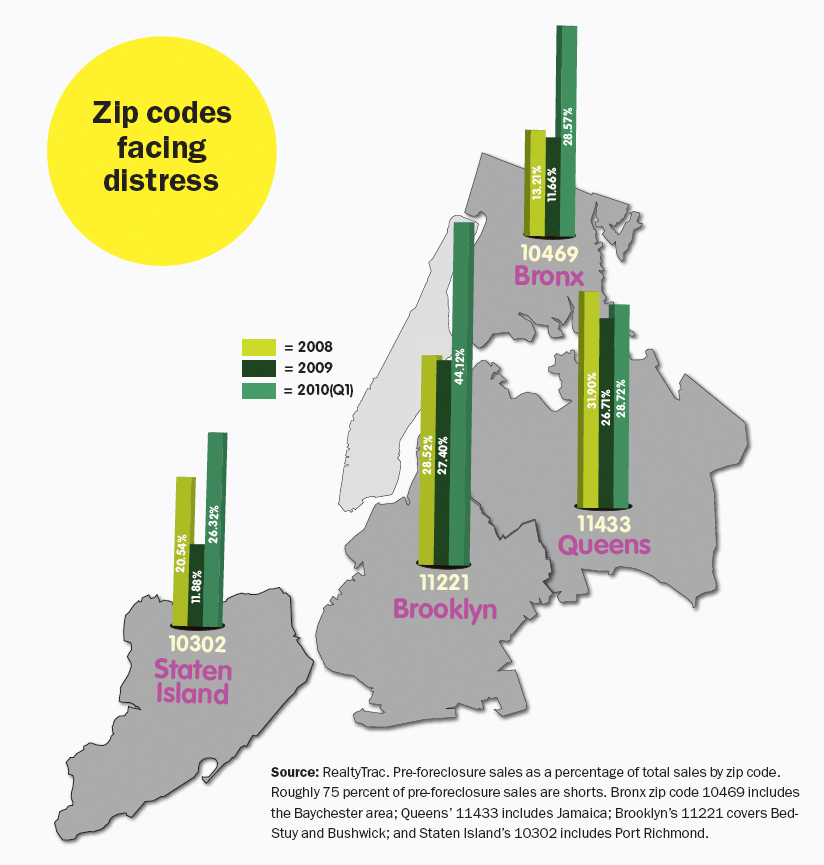Trending
Shorts hit New York City
Underwater homeowners face reality and take loss in sales

Click
the image for a larger version. Source: RealtyTrac. Pre-foreclosure
sales as a percentage of total sales by zip code. Roughly 75 percent of
pre-foreclosure sales are shorts. Bronx zip code 10469 includes the
Baychester area; Queens’ 11433 includes Jamaica; Brooklyn’s 11221
covers Bed-Stuy and Bushwick; and Staten Island’s 10302 includes Port
Richmond. The short-sale trend sweeping the rest of the country has
stormed into New York City, with some areas in Queens, the Bronx and
Brooklyn far outpacing the national average.
Research conducted by online foreclosure marketplace RealtyTrac for The Real Deal
shows that pre-foreclosure sales — of which roughly 75 percent are
shorts — are spiking dramatically in a few zip codes here. In several
areas of Queens, Brooklyn, Staten Island, and the Bronx,
pre-foreclosure sales were 20 to 40 percent of all sales in the first
quarter of this year, far outpacing the national average of 12 percent.
Short sales, which occur when a home is sold for less than what is
owed on the mortgage, are also on the rise in New York City overall.
“There’s been a lot of discussion that short sales are coming, but
the reality is they are here,” said Jonathan Miller, CEO of Manhattan
real estate appraisal firm Miller Samuel.
Manhattan, however, remains largely unscathed, with just 15 pre-foreclosure sales in the first quarter of 2010.
The neighborhoods with the highest percentages of short sales so
far this year include Morrisania and Baychester in the Bronx; East New
York, Bushwick and Bedford-Stuyvesant in Brooklyn; Jamaica, Far
Rockaway and South Ozone Park in Queens; and Elm Park and Port Richmond
in Staten Island.
While RealtyTrac records pre-foreclosure sales that are already
underway, more are hitting the market. StreetEasy lists 77 short sales
on the market in the neighborhoods that have been the busiest in
Queens, Brooklyn and Staten Island. The current total of listings for
Queens is 1,368, according to calculations from Philip Tesoriero,
broker/owner of Exceptional Homes Real Estate on Long Island, based on
data from the Long Island Multiple Listing Service.
Perhaps not surprisingly, the hotbeds of short-sale activity
correlate closely to foreclosure activity. The 10469 zip code in the
Bronx, for example, has one of the highest percentages of short sales
in the county. It also has the highest percentage of foreclosures in
the county, according to RealtyTrac, which is based in California.
The zip code’s raw number of short sales for the first quarter is
small, about 10, but the growth rate and comparisons with last year
reveal a troubling acceleration. Short sales in 10469 — which covers
Baychester — in the first quarter were about half the total for all of
last year.
Broker Jacqueline Edwards of Perfect Quarters is seeing the uptick
in short sales in 10469. She believes the area has suffered from
widespread mortgage fraud, and many homeowners are struggling with
option-ARM loans far above what they can afford.
“There’s more short sales for sure,” said Edwards. “The majority
are people I spoke to last year who were in denial and trying to do
loan modifications.”
In Brooklyn, two zip codes that cover Bushwick, Bedford-Stuyvesant
and East New York led in short sales for the first quarter, and also
had among the highest percentages of foreclosures in the borough.
Short sales are rising in part because many cash-strapped sellers
are not obtaining modifications through the government’s Home
Affordable Modification Program, or HAMP — or the mods aren’t
effective. The federal government has also encouraged short sales this
year with incentive payments to loan servicers and banks. Banks,
meanwhile, are taking the losses and approving short sales to avoid the
cost and hassle of foreclosures.
What’s more, New York State has an exceptionally long foreclosure
cycle, which gives more time for seller and bank to hammer out a
short-sale deal. In New York, the average foreclosure process can last
more than 450 days, according to Rick Sharga, senior vice president of
RealtyTrac.
He contrasts that to Texas, which he said has the shortest cycle in
the nation at just 21 days, leaving little time to arrange a short sale
as an alternative to a foreclosure.
The spike in short sales in certain New York City neighborhoods
will put continued downward pressure on housing prices there. Some real
estate experts expect the trend to dampen the wider metro area’s
recovery, too, as they become more common throughout the city as a
whole. In addition to selling at a discount, short sales often take
several months longer to close than traditional sales, dragging out
their time on the market.
“There tend to be more severe discounts associated with them, and
as the volume goes up, it serves to temper the possibility that housing
prices will head upward over the next few years,” said Miller.
While acknowledging the hits to pricing and inventory levels,
RealtyTrac’s Sharga also noted that short sales help the market work
through troubled inventory. They allow homeowners to exit properties
they cannot afford.
“Along these lines, it’s probably a good sign to see an
acceleration of short sales, as it gives the marketplace a chance to
get through this correction,” said Sharga.




